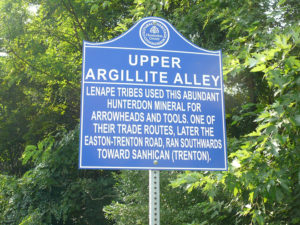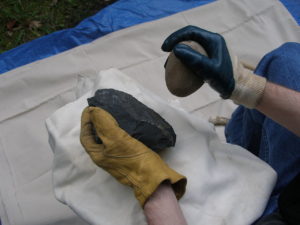Argillite of Hunterdon County
(Edited from an article for HCHS by Dr. Gregory Herman, 2018)
Argillite is an abundant, comparatively hard, relatively homogenous and isotropic rock that can be shaped and molded in any direction. Argilite was commonly crafted from dimensional blocks and splinters of bedrock into sharp, durable tools and weapons by the American Indians of Hunterdon County and surrounding areas.
Argillite is the most common stone material represented in the HCHS collection of Native American artifacts, especially those of local origin. Argillite is a light- to dark, variously colored, hardened mudrock having red, purple, brown, green, and blue varieties.

Argillite is commonly found in the northwestern portion of New Jersey, much of which was formed in the Newark Basin, which extends from Clinton to Trenton, with its center near Flemington. Argillite Alley in Hunterdon County marks an abundant deposit of the material much sought after by the Native Americans. The material was used for the making of projectile points and tools. The early trade route for the quarry and trade of argillite ran from Hunterdon County to the Trenton region, southward over the Easton-Trenton roadway, now known as River Road/ Route 29.

Argillite is a fine-grained sedimentary rock composed predominantly of clay particles. Argillaceous rocks are lithified muds and oozes and contain variable amounts of silt-sized particles. The argillites grade into shale when the fissile layering typical of shale is developed. Because of the characteristics of the argillite, it could be worked by hammerstones into durable stone tools, points and spears.
As reported by Max Schrabish, one of New Jersey’s first professional Archaeologists, when referring to a dark blue argillite Indian artifact that was buried below a colonial campsite at Pluckemin, NJ, he describes argillite as occurring:
“…chiefly in the mountains district northward and west of Flemington, Hunterdon County. It was extensively quarried by the red man, having been highly prized by them because of the excellent material it furnished, in lieu of flint, quartz, jasper, for the manufacturer of arrow heads and spear points.”
Henry Kummel, State Geologist for the State of New Jersey during the 20th century, reported on the Newark System of New Jersey in The Journal of Geology (1898) providing a useful description:
“…hard, massive, black and bluish-purple argillites, which break sharply in any direction with a marked conchoidal fracture, but never split into thin layers of which afford slabs nine or ten feet in diameter and three or four inches thick.”
References
Henry B. Kümmel, 1897, The Newark System of New Jersey: The Journal of Geology Vol. 5, no. 6, 541-562.
Schrabisch, Max, 1917a , General Knox’s Artillery Park, Pluckemin: in Honeyman, A. V. D., (ed.) Somerset County Historical Quarterly, Vol. VI., 161-168.
Support for this program is provided in part by a grant from the Astle-Alpaugh Family Foundation. A special thanks to Mr. Bob Sands, Project Manager and consultants Dr. Richard Veit and Dr. Gregory Herman.
